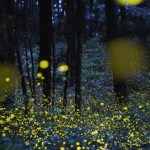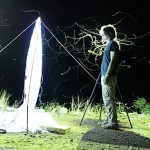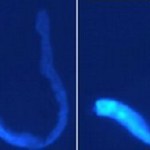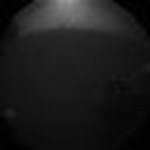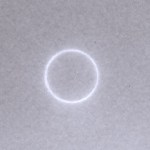Light
New research shows how octopus skin is able to respond to variations in light
Jeff Cremer, a nature photographer, discovered mysterious tiny glow worms (~0.5 inches long) in Peru near the Tambopata Research Center a couple of years ago. Scientists still have not identified the species of these glow "worms", but suspect they are actually click beetle larvae. Entomologists Aaron Pomerantz, Mike Bentley, and Geoff Gallice from the University of Florida decided to go to Peru to investigate the worms. Here is what they found:
Have you had a chance to see this video from Discovery News showing the flashy 'disco clam'? A graduate student at UC Berkeley, Lindsey Dougherty, unraveled the mystery of this party-like effect. The clams actually have tiny silica spheres (340 nanometers in diameter) on the inside of their lips that reflect light whereas the outside of their lips is devoid of nanospheres. This is a rather unique method to put on a flashy show in the ocean as other creatures of the deep use bioluminescence whereas these clams just unfurl their lips to reflect the ambient light in the ocean around two…
Eran Levin in front of a blacklight screen.
Eran Levin, a postdoctoral researcher at the University of Arizona studies Hawk Moths. He used a technique called backlighting to catch them and in the process catches numerous other insects as well.
Moths navigate by keeping bright objects like the moon and stars at a constant angle. It turns out that artificial light disrupts the moths's detection of moonlight. They end up using the artificial light source as a navigation cue and as a result wind up circling the light bulb to keep it at a constant angle.
Check out his blog entry in Scientific…
Dying nematode worm. Image: Cassandra Coburn
Dr. Gems, University College London, and colleagues were studying aging using nematode worms. They discovered that dying nematode worms emit a wave of blue light from dying cells. It was previously thought that damaged components of aging cells collect in lysosomes forming what they call lipofuscin, which fluoresces. His team refuted that long-held belief and showed that the dying light was produced instead by anthranilate, a substance that is inactive in the acidic environment of the gut but becomes activated when cells die (necrosis) and…
"As far as we can discern, the sole purpose of human existence is to kindle a light in the darkness of mere being." -Carl Jung
During the daytime, light is plentiful and abundant, and the majority of our waking lives are optimized for that. But more and more of us are active late into the dark hours, when -- as Owen Pallett (formerly Final Fantasy) would tell us -- the last of
Your Light is Spent.
Unfortunately for us, our bodies are accustomed to certain types of light during the day, and expect a different type of night at light.
Image credit: TableTop Studio Ltd or LLC.
Because…
"The colors of a rainbow so pretty in the sky.
Are also on the faces of people going by." -Louis Armstrong
It's no secret that white light is the light that we see when all the colors shine together and are seen at once. This has been known for over 400 years, when Isaac Newton demonstrated that white light could be broken up into all the known colors by dispersing it through a prism.
Image credit: Adam Hart-Davis.
All that we're doing is breaking white light -- in this case, sunlight -- up into all of its component colors. This can be done artificially (such as by configuring a prism) or…
The NASA Mars rover Curiosity just landed on Mars. Those of us who tuned in vicariously via NASA's live coverage watched as a roomful of tense engineers exploded, and heard their disembodied voices whispering and booming through the control room. Holy shit. We did it. Their headsets fell askew, they glad-handed one another, criss-crossing the room, and then, immobilized by a sudden hush as the news spread: We've got thumbnails.
Thumbnails. We watched as a tiny image formed, transmuted across the void of space and into this room. It was black and white, an indistinguishable gesture of light…
The pupils of mice that were injected with the light-sensitive chemical constricted when exposed to bright light (right) in contrast to mice that were not injected (left). Image from Polosukhina et al., 2012.
By injecting the eyes of blind mice with a chemical called AAQ, Dr. Richard Kramer and colleagues at UC Berkeley and the University of Washington have found that the animals are able to detect bright light. When these treated mice were exposed to an LED lamp, they actually turned and ran away from the light. Moreover, their pupils contracted in response to bright light, another…
"The moon shuts off the beams of the sun as it passes across it, and darkens so much of the earth as the breadth of the blue-eyed moon amounts to." -Empedocles, ~450 B.C.
Less than two weeks ago, I saw my first annular eclipse, with some spectacular results at the moment of maximum eclipse.
From my first eclipse expedition, to False Klamath Cove, on the coast in northern California.
This happens, of course, because -- from our point of view -- the Moon appears to pass in front of the Sun, blocking a fraction of the light coming from it.
Image credit: NASA / Solar Dynamics Observatory.
And…
"This seems to be the law of progress in everything we do; it moves along a spiral rather than a perpendicular; we seem to be actually going out of the way, and yet it turns out that we were really moving upward all the time." -Frances Willard
As spring gives way to summer here in the Northern Hemisphere, one of the most beloved sights of the night sky becomes ever more prominent: the Big Dipper.
(Image credit: NASA, ESA, Z. Levay (STScI) and A. Fujii.)
These seven bright stars shine high above the horizon after sunset, and will continue to do so over the rest of the Spring and all Summer…
Spring is a trick of the light - it should be, after all, since ultimately the shift of seasons is about angles and sun. At some point in March the light changes - a new "certain slant of light" and thus, spring is here. It will be a while most years before the green and the daffodils or even the spring peepers arrive in upstate NY, but in the meantime, the sky and the air and the angle of sun says spring.
Seed starting is in full swing now and I sometimes feel I spend far too many of my days elbow deep in potting soil - but the smell of moist compost is energizing as well. It is…
It's been a long and brutally busy week here, so I really ought to just take a day off from blogging. But there's a new paper in Science on quantum physics that's just too good to pass up, so here's a ReasearchBlogging post to close out the week.
Aw, c'mon, dude, I'm tired. What's so cool about this paper that it can't wait until next week? Well, the title kind of says it all: they measured the average trajectories of single photons passing through a double-slit apparatus. By making lots of repeated weak measurements at different positions behind the slits, they could reconstruct the average…
The theory of relativity takes its name from a very simple and appealing idea: that the laws of physics should look the same to moving observers as to stationary ones. "Laws of physics" here includes Maxwell's equations for electricity and magnetism, which necessarily means that moving observers must see the same speed of light as stationary observers (Einstein included the constancy of the speed of light as a second postulate in his original relativity paper, but it's redundant-- the constancy of the speed of light is a direct consequence of the principle of relativity). This leads directly…
Congratulations Fran. Not only did she answer the "What the heck is this?" correctly, she was the first commenter.
Here is the original item:
It is of course a gas discharge tube. You put these tubes in there (as shown above) with helium or neon or whatever in there and it excites the gas to give off light.
Honestly, we have like 10 of these things laying around. Some of them are newer and say "Danger 5000 volts"), but these older ones say nothing. Here is an example of one of the first ones I saw.
I didn't figure out what it was for a while because most of the ones we have don't have those…
A while ago, we had a ton of lightning. As a bonus, it always happened in the middle of the night. I love sleeping where it sounds like I am on the front line in WWI - no, I don't. But, while lying awake waiting for the next BOOM I thought of something. Instead of just counting the time between flash and boom, maybe I could make a lightning detector.
For mere mortals, the first step might be to google "lightning detector". I don't want to do that. What fun would that be? I did look up something. The current in a typical lightning strike is on the order of 30,000 amps. How could I…
In my post about how we know photons exist, I make reference to the famous Kimble, Dagenais, and Mandel experiment showing "anti-bunching" of photons emitted from an excited atom. They observed that the probability of recording a second detector "click" a very short time after the first was small. This is conclusive evidence that photons are real, and that light has discrete particle-like character. Or, as I said in that post:
This anti-bunching effect is something that cannot be explained using a classical picture of light as a wave. Using a wave model, in which light is emitted as a…
There is this commercial that has been coming on lately showing some people reading the Kindle at the beach. Why is this a selling point? It has to do with the way the Kindle works compared to something like the iPad. I would take a picture, but I have neither of these devices. Instead, I will make a diagram.
Maybe you can't tell from my diagram, but I am using the black rays to represent light reflected from the Kindle and red rays to represent light produced from the iPad. And that is the key. The Kindle does not have a light source, it is very similar to a piece of paper. The iPad…
The Lord of the Rings trilogy came on TV again recently. My wife and I can't help but to watch this even though we have it on DVD. Anyway, I was thinking about the part where Gondor sends a signal to Rohan asking them for military aid. Since this was before the invention of email, they had to do it with a signal fire. Hopefully this clip won't be a spoiler for you, but this is from the movie. Actually, all of the clips available have embedding disabled. So this is just a picture of that clip. If you want to see it, go to the youtube version.
One other spoiler: Sauron is really Frodo's…
Sometimes I get asked to do some demos for kids. I like this, it is fun. This week, I was asked to do just such a demo. Kind of as a historical record, I am going to document what I did.
The audience
It is always important to think about who you are talking to. Is this a group of high school physics students? High school teachers? Middle school teachers? Kids? It could be anything. In this case, I was meeting with a group of kids from ages 8 to 12 as part of a science camp.
The Objective
Is there a reason for the demo show? In this case, there was no stated objective. That means I can…
